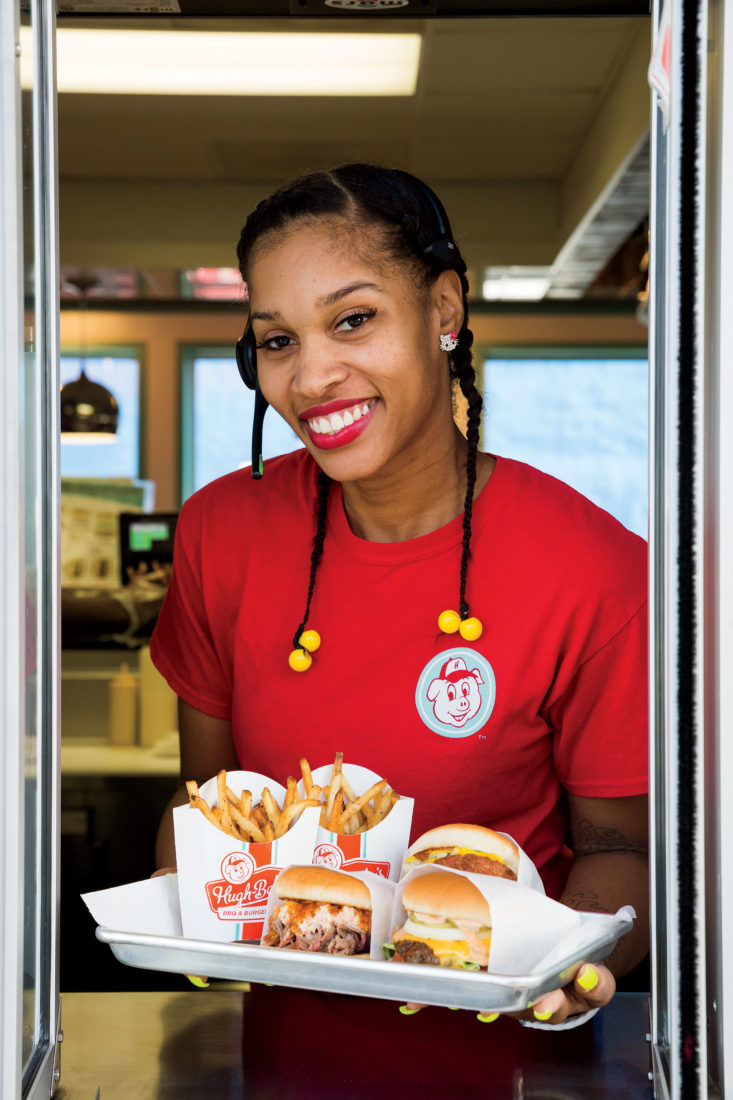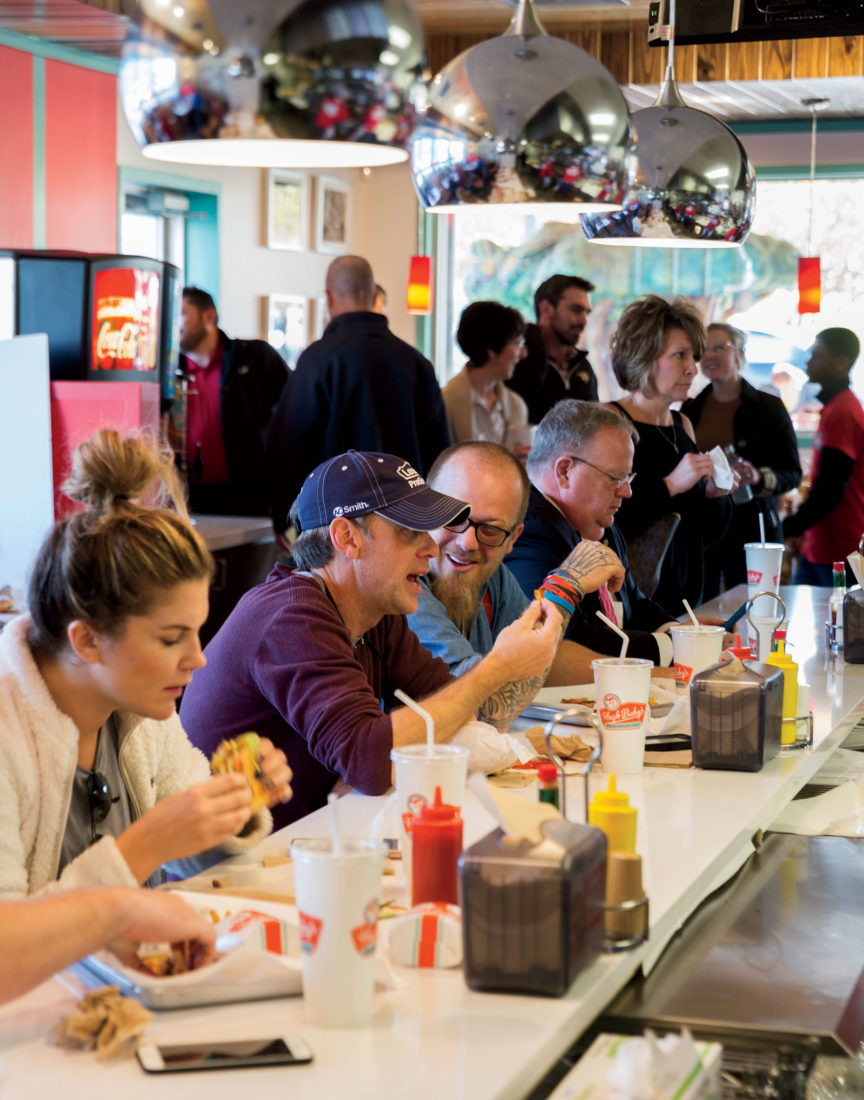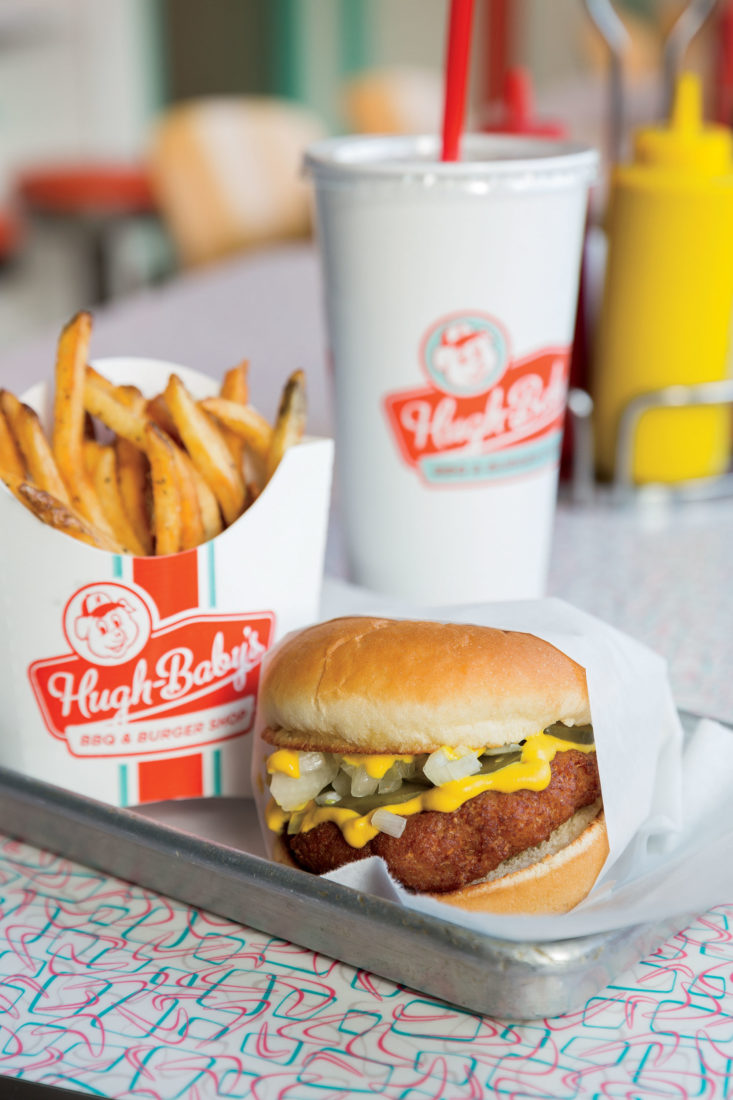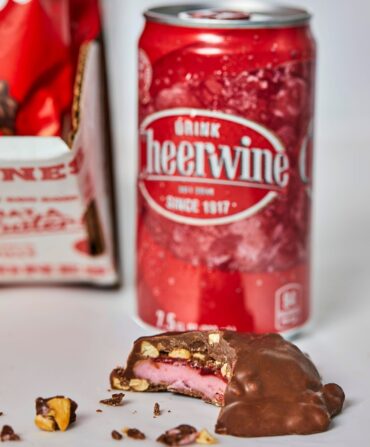Two old pickups and one new Jag idle in the drive-through. Out front, a mother and her three children gambol on an artificial-turf playground, strewn with toy cars and dump trucks. Her son, Paxton, has abandoned his attempt to ride a monster fiberglass snail like a pony. Now he clambers up a fiberglass tree house, fronted by a pink fiberglass pig dressed in red overalls. Seated at a table nearby, his uncle (that’s me) reaches for a flattop-fried burger, draped in American cheese, wrapped in a paper sleeve, and served alongside a stack of fries and a cherry-crowned strawberry milk shake on a retro-cool aluminum tray.
Hugh-Baby’s, a fast-food concept for the twenty-first century, opened this past summer, on the western fringe of Nashville in the shadow of I-40. With family roots in Corinth, Mississippi, founder Pat Martin made his name cooking whole hog at Martin’s Bar-B-Que Joint. (Disclosure: That company donates to the organization I direct, the Southern Foodways Alliance.) Since the first Nashville-area spot opened, in 2006, Martin’s has expanded to six locations, including a multistory downtown behemoth that looks like a beach house for barbecue obsessives. Pat Martin built Hugh-Baby’s for expansion, too. He first tested the concept in a food court at West Virginia University, the alma mater of one of his business partners. He now plans to open two more full-scale Hugh-Baby’s locations in Nashville this year.

Photo: Luis Garcia
Charquise Scales at the window.
Along with burgers, Hugh-Baby’s serves nostalgia. Workers wear red logo-blazoned ball caps with white mesh backs, lifted from 1975. Eight squat stools face a white counter. Installed above the cash registers, a coffered wood ceiling recalls a sleeping porch at a lake house.
This is a new sort of Southern nostalgia. Hugh-Baby’s does not reference an antebellum South or gesture to the
agricultural roots of the region. The concept delivers a quick-focus snapshot of the 1970s. Martin regards that era as a golden age of fast food, before fast became synonymous with schlock, when McDonald’s still cooked fries in beef tallow. “Remember when Wendy’s was actually good?” Martin says. “That’s what we’re going for. Fast food should be about speed of service, not crappy food.”
Many of America’s bedrock fast-food companies were born in the South. The corporation now known as KFC opened its first location in Corbin, Kentucky, in 1930. Burger King began in Jacksonville, Florida, in 1953. Chick-fil-A first sold pickle-topped chicken breast sandwiches in a suburban Atlanta mall in 1967. Fast food has been part of the region long enough to inspire the fond recollections on which nostalgia is built. But Martin aims to run more than a mere bunker for reminiscence and indulgence.
Hugh-Baby’s is a very personal place. That’s an absurd thing to say about a fast-food outlet. But here it’s true, starting with the name, which references Martin’s late uncle, fabled for his outsize personality and appetite. The music fits that bill, too. Remember ten years back when the cool-kid restaurants began hooking their sound systems to chefs’ iPods? The music played like an expression of the chef’s id and became a key component of the vibe. Pulsing from the speakers at Hugh-Baby’s, Pat Martin’s id sounds like the Apache Relay, Jason Isbell, and Sturgill Simpson.

Photo: Luis Garcia
Customers line the old-fashioned counter.
Martin mixes old and new in ways that plumb his childhood in North Mississippi and midlife in Middle Tennessee. Photographs of burger shacks and barbecue huts line the walls: Staggs Grocery in Florence, Alabama, famous for biscuits drenched in chocolate gravy. White Trolley Cafe in Corinth, where MoonPies and mini pecan pies line the counter. Helen’s Bar-B-Q in Brownsville, Tennessee, where Helen Turner works two pits, set in a rear screened room. Meanwhile, flat-screen monitors, mounted over the cash registers, flash descriptions of Hugh-Baby’s hot dogs capped with celery-seed slaw, and smoked turkey sandwiches slathered in white barbecue sauce. Prices are low. Fried smoked bologna sandwiches cost four bucks. Slugburgers—deep-fried grinds of soy meal, pork, and sage-flavored pork sausage, long popular in the Tennessee Valley region—sell for two bucks and change.
In a moment of rapid expansion for Shake Shack, the fast-food chain hatched by fine-dining restaurateur Danny Meyer, Martin has staked a claim to regional distinctiveness, grounded in specialties that his rivals aren’t likely to mimic. Hugh-Baby’s does right by barbecue, serving tidy sandwiches of chopped pork, pocked with crispy bits of skin. On Fridays only, Martin serves slugs. He initially thought he’d draw customers who grew up on fried soy burgers, tucked in compact white buns. Turns out, when you build a burger—even a slugburger—with integrity and sell it at a low price, an audience finds you.
With Hugh-Baby’s, Pat Martin showcases one way fast food might transcend its rep as a lowest-common-denominator calorie-delivery vehicle. Slugburgers are signal to his promise. But I continue to fix on the crisp and caramelized beef burgers, blanketed in cheese, stacked with pickles and onions, swabbed with mustard. Just before joining my family out front on the playground, I stood inside to watch the kitchen crew work. As a line cook spatula-smashed a patty and dragged a slice of American across the griddle to soften, I glimpsed a future when fast food might also be good food.








